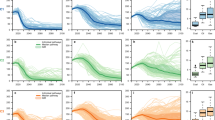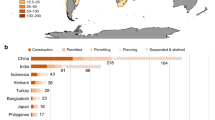Abstract
We develop a methodology with which to assess the effects of policy instruments on the long-term abatement and costs of carbon capture and storage (CCS) technologies for coal power plants. Using an expert elicitation, historical data on the determinants of technological change in energy, values from the engineering literature, and demand estimates from an integrated assessment model, we simulate ranges of outcomes between 2025 and 2095. We introduce probability distributions of all important parameters and propagate them through the model to generate probability distributions of electricity costs, abatement costs, and CO2 avoided over time. Carbon pricing has larger effects than R&D and subsidies. But much of the range of outcomes is driven by uncertainty in other parameters, such as capital costs and returns to scale. Availability of other low carbon technologies, particularly bioenergy with CCS affects outcomes. Subsidies have the biggest impacts when they coincide with expanding manufacturing scale of CCS components. Our results point to 4 parameters for which better information is needed for future work informing technology policy to address climate change: capital costs, demonstration plants, growth constraints, and knowledge spillovers among technologies.





Similar content being viewed by others
Notes
The use of the acronym ‘CCS’ throughout this paper refers to carbon capture installed on coal-fired power plants.
We use the following abbreviations for these 7 CCS technologies: Abs=absorption, Ads=adsorption, Mem=membranes, Oth=other post-combustion, Pre=pre-combustion, Oxy=oxyfuel, CLC=chemical looping combustion.
References
Argote L, Epple D (1990) Learning curves in manufacturing. Science 247 (4945):920–924
Arrow K (1962) The economic implications of learning by doing. Rev Econ Stud 29(3):155–173
Azar C, Lindgren K, Obersteiner M, Riahi K, van Vuuren D, den Elzen K, Mllersten K, Larson E (2010) The feasibility of low CO2 concentration targets and the role of bio-energy with carbon capture and storage (BECCS). Clim Chang 100 (1):195–202
Baker E, Chon H, Keisler J (2009) Carbon capture and storage: combining economic analysis with expert elicitations to inform climate policy. Clim Chang 96 (3):379–408
Baker E, Nemet G, Rasmussen P (2012) Modeling the Costs of Carbon Capture. Springer, Berlin Heidelberg, pp 349–372
Brenkert AL, Smith AJ, Kim SH, Pitcher HM (2003) Model documentation for the MiniCAM. Pacific Northwest National Laboratory Richland, WA
van den Broek M, Hoefnagels R, Rubin E, Turkenburg W, Faaij A (2009) Effects of technological learning on future cost and performance of power plants with CO2 capture. Prog Energy Combust Sci 35(6):457–480
Chan G, Anadon LD, Chan M, Lee A (2011) Expert elicitation of cost, performance, and RD&D budgets for coal power with CCS. Energy Procedia 4:2685–2692
Chung TS, Patio-Echeverri D, Johnson TL (2011) Expert assessments of retrofitting coal-fired power plants with carbon dioxide capture technologies. Energy Policy 39(9):5609–5620
Clarke JF, Edmonds JA (1993) Modelling energy technologies in a competitive market. Energy Econ 15(2):123–129
Edmonds J, Luckow P, Calvin K, Wise M, Dooley J, Kyle P, Kim S, Patel P, Clarke L (2013) Can radiative forcing be limited to 2.6wm2 without negative emissions from bioenergy and co2 capture and storage Clim Chang 118(1):29–43
Grubler A, Wilson C (2013) Energy technology innovation: learning from historical successes and failures. Cambridge University Press, Cambridge
Haldi J, Whitcomb D (1967) Economies of scale in industrial plants. J Polit Econ 75(4):373–385
Hamilton MR (2009) An analytical framework for long term policy for commercial deployment and innovation in carbon capture and sequestration technology in the United States. Thesis
Herzog HJ (2011) Scaling up carbon dioxide capture and storage: From megatons to gigatons. Energy Econ 33(4):597–604
IEA (2012) Energy Technology Perspectives: Pathways to a clean energy system. International Energy Agency (IEA), Paris
IPCC (2014) Summary for Policymakers. Cambridge University Press, Cambridge
Jenni KE, Baker ED, Nemet GF (2013) Expert elicitations of energy penalties for carbon capture technologies. Int J Greenhouse Gas Control 12:136–145
JGCRI (2014) Global Change Assessment Model GCAM wiki., http://wiki.umd.edu/gcam/
Joskow PL, Rozanski GA (1979) The effects of learning by doing on nuclear plant operating reliability. Rev Econ Stat 61(2):161–168
Kim SH, Edmonds J, Lurz J, Smith SJ, Wise M (2006) The ObjECTS framework for integrated assessment: Hybrid modeling of transportation. The Energy Journal, 63–91
Knoope MMJ, Meerman JC, Ramirez A, Faaij APC (2013) Future technological and economic performance of igcc and ft production facilities with and without co2 capture: Combining component based learning curve and bottom-up analysis. Int J Greenhouse Gas Control 16:287–310
Koelbl B, Broek M, Faaij AC, Vuuren D (2014) Uncertainty in carbon capture and storage (ccs) deployment projections: a cross-model comparison exercise. Clim Chang 123(3-4):461–476
Kriegler E, Weyant J, Blanford G, Krey V, Clarke L, Edmonds J, Fawcett A, Luderer G, Riahi K, Richels R, Rose S, Tavoni M, Vuuren D (2014) The role of technology for achieving climate policy objectives: overview of the emf 27 study on global technology and climate policy strategies. Clim Chang 123(3-4):353–367
Li S, Zhang XS, Gao L, Jin HG (2012) Learning rates and future cost curves for fossil fuel energy systems with CO2 capture: Methodology and case studies. Appl Energy 93:348–356
Lohwasser R, Madlener R (2013) Relating R&D and investment policies to ccs market diffusion through two-factor learning. Energy Policy 52(0):439–452
Luderer G, Bertram C, Calvin K, Cian E, Kriegler E (2013) Implications of weak near-term climate policies on long-term mitigation pathways. Clim Chang:1–14
Magne B, Kypreos S, Turton H (2010) Technology options for low stabilization pathways with merge. Energy J 31(1):83–108
Markusson N, Ishiii A, Stephens JC (2012) Learning in CCS demonstration projects: social and political dimensions. Routledge:222–244
McCollum D, Bauer N, Calvin K, Kitous A, Riahi K (2014) Fossil resource and energy security dynamics in conventional and carbon-constrained worlds. Clim Chang 123(3-4):413–426
McFadden D (1974) Conditional logit analysis of qualitative choice behavior. Academic Press, New York, pp 105–142
Middleton RS, Bielicki JM (2009) A scalable infrastructure model for carbon capture and storage: Simccs. Energy Policy 37(3):1052–1060
Nemet GF (2012) Inter-technology knowledge spillovers for energy technologies. Energy Econ 34(5):1259–1270
Nemet GF, Baker E (2009) Demand subsidies versus R&D: Comparing the uncertain impacts of policy on a pre-commercial low-carbon energy technology. Energy J 30(4):49–80
Nemet GF, Brandt AR (2012) Willingness to pay for a climate backstop: liquid fuel producers and direct CO2 air capture. Energy J 33(1):53–82
Nemet GF, Baker E, Jenni KE (2013) Modeling the future costs of carbon capture using experts’ elicited probabilities under policy scenarios. Energy 56:218–228
NRC (2007) Prospective evaluation of applied energy research and development at DOE (Phase Two). The National Academies Press, Washington
Rao AB, Rubin ES, Keith DW, Granger Morgan M (2006) Evaluation of potential cost reductions from improved amine-based CO2 capture systems. Energy Policy 34(18):3765–3772
Remer DS, Chai LH (1990) Design cost factors for scaling-up engineering equipment. Chem Eng Prog 86(8):77–82
Rubin ES, Chen C, Rao AB (2007a) Cost and performance of fossil fuel power plants with CO2 capture and storage. Energy Policy 35(9):4444–4454
Rubin ES, Yeh S, Antes M, Berkenpas M, Davison J (2007b) Use of experience curves to estimate the future cost of power plants with CO2 capture. Int J Greenhouse Gas Control 1(2):188–197
Scherer FM, Harhoff D (2000) Technology policy for a world of skew-distributed outcomes. Res Policy 29(4-5):559–566
Sinclair G, Klepper S, Cohen W (2000) Sources of cost reduction in a large specialty chemicals producer. Manag Sci 46(1):28–45
Tavoni M, De Cian E, Luderer G, Steckel J, Waisman H (2012) The value of technology and of its evolution towards a low carbon economy. Clim Chang 114(1):39–57
Teece DJ (1986) Profiting from technological innovation - implications for integration, collaboration, licensing and public-policy. Res Policy 15(6):285–305
Weyant JP (2011) Accelerating the development and diffusion of new energy technologies: Beyond the “valley of death”. Energy Econ 33(4):674–682
Wilson C, Grubler A, Bauer N, Krey V, Riahi K (2013) Future capacity growth of energy technologies: are scenarios consistent with historical evidence Clim Chang 118(2):381–395
Wright TP (1936) Factors affecting the costs of airplanes. J Aeronaut Sci 3:122–128
Acknowledgements
This project was partially supported by the NSF Program on the Science of Science Policy under awards No. SMA-0960993 and SMA-0962100. Thanks also for comments from reviewers as well as those received in presentations at: APPAM, IEW, MIT, USAEE, and UT-Austin.
Author information
Authors and Affiliations
Corresponding author
Electronic supplementary material
Below is the link to the electronic supplementary material.
Rights and permissions
About this article
Cite this article
Nemet, G.F., Baker, E., Barron, B. et al. Characterizing the effects of policy instruments on the future costs of carbon capture for coal power plants. Climatic Change 133, 155–168 (2015). https://doi.org/10.1007/s10584-015-1469-0
Received:
Accepted:
Published:
Issue Date:
DOI: https://doi.org/10.1007/s10584-015-1469-0




